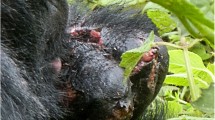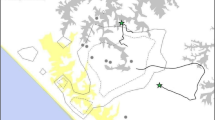Abstract
During 12 years of observation, we have observed three confirmed and two inferred lethal coalitionary attacks on adult male white-faced capuchins (Cebus capucinus) by members of two habituated social groups at Lomas Barbudal Biological Reserve, Costa Rica. In one case, an alpha male was badly wounded and evicted from his group, and when later found by his former groupmates he was attacked by several of them and died less than 24 h later. In two other cases, lone extra-group males were mobbed by adult and immature males of a bisexual group. One victim's abdomen was torn open and he died less than 24 h later. A second victim was quite badly bitten but may have escaped. The fourth and fifth cases resulted from intergroup encounters. One victim lost the use of both arms but may have survived, whereas the other died of unknown causes within an hour of the attack. The observed death rate from coalitionary aggression at our site is approximately the same as that reported for eastern chimpanzees. Because at least three of the five observed incidents involved large coalitions attacking lone victims, they support the general hypothesis that imbalances of power contribute to intraspecific killing in primates. However, the occurrence of lethal coalitional attacks in a species lacking fission–fusion social organization poses a challenge to the more specific version of the imbalance-of-power hypothesis proposed by Manson and Wrangham in 1991 to explain chimpanzee and human intergroup aggression.
Similar content being viewed by others
References
Cheney DL, Seyfarth RM, Silk JB (1995) The responses of female baboons (Papio cynocephalus ursinus) to anomalous social interactions: evidence for causal reasoning? J Comp Psychol 109:134–141
Dasser V (1988) A social concept in Java monkeys. Anim Behav 36:225–230
Fawcett K, Muhumuza G (2000) Death of a wild chimpanzee community member: possible outcome of intense sexual competition. Am J Primatol 51:243–247
Fedigan LM (2003) The impact of male take-overs on infant deaths, births and conceptions in Cebus capucinus at Santa Rosa, Costa Rica. Int J Primatol, in press
Fedigan LM, Rose LM, Morera Avila R (1997) See how they grow: tracking capuchin monkey (Cebus capucinus) populations in a regenerating Costa Rican dry forest. In: Norconk MA; Rosenberger AL, Garber PA (eds.), Adaptive radiations of neotropical primates. Plenum, New York, pp 289–308
Gros-Louis J (2002) Contexts and behavioral correlates of trill vocalizations in wild white-faced capuchin monkeys (Cebus capucinus). Am J Primatol 57:189–202
Hrdy SB (1974) Male-male competition and infanticide among the langurs (Presbytis entellus) of Abu, Rajasthan. Folia Primatol 22:19–58
Janson CH, Schaik CP van (2000) The behavioral ecology of infanticide by males. In: Schaik CP van, Janson CH (eds) Infanticide by males and its implications. Cambridge University Press, Cambridge, pp 469–494
Manson JH, Wrangham RW (1991) Intergroup aggression in chimpanzees and humans. Curr Anthropol 32:369–390
Manson JH, Perry SE, Parish AR (1997) Nonconceptive sexual behavior in bonobos and capuchins. Int J Primatol 18:767–786
Manson JH, Gros-Louis J, Perry S (2003) Three apparent cases of infanticide by males in wild white-faced capuchins (Cebus capucinus). Folia Primatol (in press)
Miller LE (1998) Fatal attack among wedge-capped capuchins. Folia Primatol 69:89–92
Nishida T (1996) The death of Ntologi, the unparalleled leader of M group. Pan Afr News 3(1)
Nishida T, Hosaka K, Nakamura M, Hamai M (1995) A within-group gang attack on a young adult male chimpanzee: ostracism of an ill-mannered member? Primates 36:207–211
Pan American Health Organization (1998) Health in the Americas, vol 2. Washington, D.C.
Perry S (1996) Intergroup encounters in wild white-faced capuchins, Cebus capucinus. Int J Primatol 17:309–330
Perry S (1998a) A case report of a male rank reversal in a group of wild white-faced capuchins (Cebus capucinus). Primates 39:51–69
Perry S (1998b) Male–male social relationships in wild white-faced capuchin monkeys, Cebus capucinus. Behaviour 135:1–34
Perry S, Barrett HC, Manson JH (2003a) White-faced capuchin monkeys exhibit triadic awareness in their choice of allies. Anim Behav (in press)
Perry S, Baker M, Fedigan L, Gros-Louis J, Jack K, MacKinnon K, Manson J, Panger M, Pyle K, Rose L (2003b) Social conventions in wild white-faced capuchin monkeys: evidence for traditions in a neotropical primate. Curr Anthropol 44:241-268
Robbins M (2003). Behavioral aspects of sexual selection in mountain gorillas. In: Jones C (ed) Special topics in primatology. Sexual selection in primates, vol. 3. Am Soc Primatol, in press
Rose L (1994) Benefits and costs of resident males to females in white-faced capuchins, Cebus capucinus. Am J Primatol 32:235–248
Rose L (1998) Behavioral ecology of white-faced capuchins (Cebus capucinus) in Costa Rica. Ph.D. thesis, Washington University, St. Louis, Mo.
Schaik CP van (2000) Infanticide by male primates: the sexual selection hypothesis revisited. In: Schaik CP van, Janson CH (eds) Infanticide by males and its implications. Cambridge University Press, Cambridge, pp 27–60
Silk JB (1992) The patterning of intervention among male bonnet macaques: reciprocity, revenge, and loyalty. Curr Anthropol 33:318–324
Silk JB (1999) Male bonnet macaques use information about third-party rank relationships to recruit allies. Anim Behav 58:45–51
Smuts BB, Smuts RW (1993) Male aggression and sexual coercion of females in nonhuman primates and other mammals: evidence and theoretical implications. Adv Stud Behav 22:1–63
Starin ED (1994) Philopatry and affiliation among red colobus. Behaviour 130:253–270
Stephan H, Barbon G, Frahm HD (1988) Comparative sizes of brains and brain components. In: Steklis HD, Erwin J (eds) Comparative primate biology, vol 4. Wiley, New York, pp 1–39
Visalberghi E, McGrew WC (1997) Cebus meets Pan. Int J Primatol 18:677–681
Waal FBM de (1982) Chimpanzee politics. Harper, New York
Waal FBM de (1986) The brutal elimination of a rival among captive male chimpanzees. Ethol Sociobiol 7:237–251
Watts DP (1989) Infanticide in mountain gorillas: new cases and a reconsideration of the evidence. Ethology 81:1–18
Watts DP, Mitani JC (2001) Boundary patrols and intergroup encounters in wild chimpanzees. Behaviour 138:299–327
Wilson ML, Hauser MD, Wrangham RW (2001) Does participation in intergroup conflict depend on numerical assessment, range location, or rank for wild chimpanzees? Anim Behav 61:1203–1216
Wrangham RW (1999) Evolution of coalitionary killing. Yrbk Phys Anthropol 42:1–30
Acknowledgements
J.G-L. was funded by the following sources: APA dissertation research award, NSF Pre-doctoral research fellowship and doctoral dissertation improvement grant, and SDE-GWIS Vessa Notchev Fellowship. S.P. received funding from the Leakey Foundation, NSF-NATO postdoctoral fellowship, Killam postdoctoral fellowship, UCLA faculty career development grant, and the Max Planck Institute for Evolutionary Anthropology. The Wenner-Gren Foundation for Anthropological Research provided funding for S.P. and J.H.M. We thank the Costa Rican Servicio de Parques Nacionales, Area de Conservacion Tempisque and Ministerio del Ambiente y Energia for granting permission to work in Lomas Barbudal; the Community of San Ramon de Bagaces for permission to work in La Reserva Agroecologica de San Ramon; Francisco Antonio Loaícíga Paniagua for permission to work in El Pelon de la Bajura; and the management of Brin D'Amour Estates to work on that property. J. Anderson, K. Atkins, T. Bishop, R. Crocetto, G. Dower, M. Duffy, M. Fuentes A., H. Gilkenson, L. Johnson, W. Meno, B. Pav, N. Parker, K. Potter, A. Steele and M. Varley helped with data collection. K. Potter, N. Parker, and two anonymous referees provided comments on the manuscript.
Author information
Authors and Affiliations
Corresponding author
About this article
Cite this article
Gros-Louis, J., Perry, S. & Manson, J.H. Violent coalitionary attacks and intraspecific killing in wild white-faced capuchin monkeys (Cebus capucinus). Primates 44, 341–346 (2003). https://doi.org/10.1007/s10329-003-0050-z
Received:
Accepted:
Published:
Issue Date:
DOI: https://doi.org/10.1007/s10329-003-0050-z




